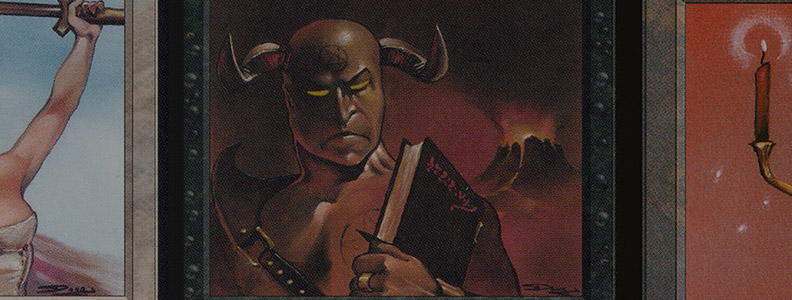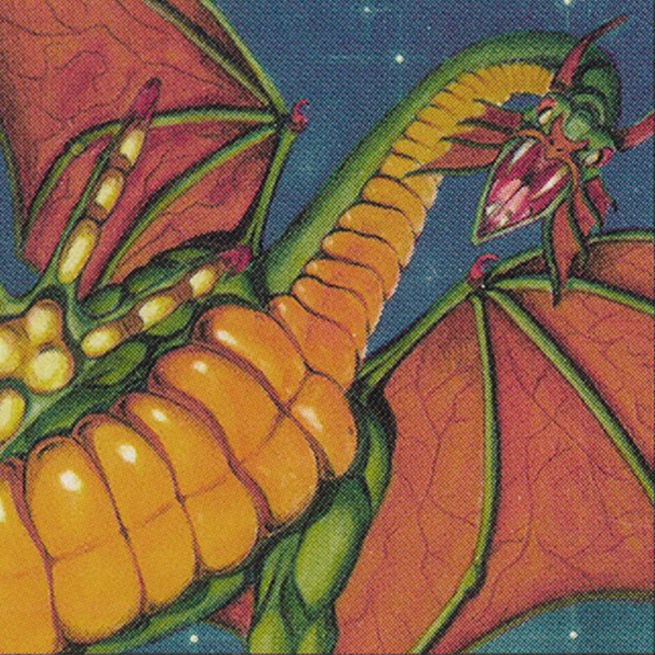Welcome to the #24 interview in the series 'There's No Magic Without Art', where we interview artists that have created incredible work for Magic: The Gathering.For today's interview we talked with one of the original 25 Magic artists, Mr. Douglas Shuler, who created some of the game's most iconic pieces.
Doug shared with some some incredible stories with us. Read on!
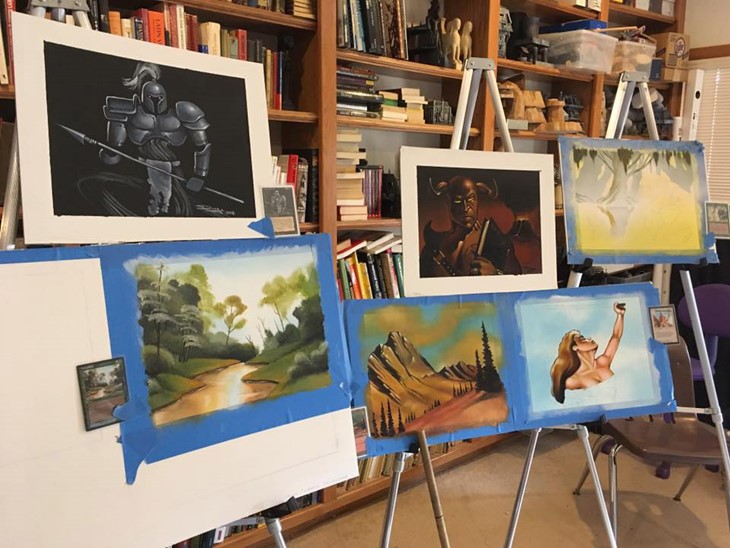
Hi Doug. You're one of the original 25 Magic artists. How did it all start?
I was in the right place at the right time.
Throughout the late 80's and early 90's, I would regularly attend gaming conventions and pass out portfolios, trying to get my work in front of art directors. It was a gamble, but I was hoping that perseverance would pay off. Eventually, I started getting my work into some of the very games I loved playing, such as Dungeons and Dragons, the Star Wars RPG, Ars Magica, GURPS, Champions, and others.
It wasn't high-paying, but I've been an active RPGer since high school and I was doing art for games mostly for the love of the industry. I was able to make just enough to justify the trip. Fortunately, one of the companies that accepted my portfolio was a little-known game company called Wizards of the Coast. I submitted my works and, a few weeks later, received my first art assignment.
Doug painting some of his most iconic images.

At what point in time did you first notice the game was a huge hit?
I first noticed that the game was a hit during the first Gen Con after Magic was released -- possibly 1993? Wizards invited a number of artists to set up at their booth and sign cards for an hour or two.
The turnout was tremendous! We had lines of 50 or more people and would autograph for hours on end, taking shifts and relieving each other when someone was getting tired. It was exhausting, but exhilarating at the same time. I couldn't explain the enthusiasm for the game or the art, figuring it would fade.
Then, I got my first fan letter. Then more came. I found out that some of our addressed were published in a magazine and I was receiving 50 letters a week. I tried to sign all the cards, but it soon became overwhelming. Some of the letters were incredibly touching and arrived from all over the world, each with a story of how Magic touched them, affected them, or awakened them to art.
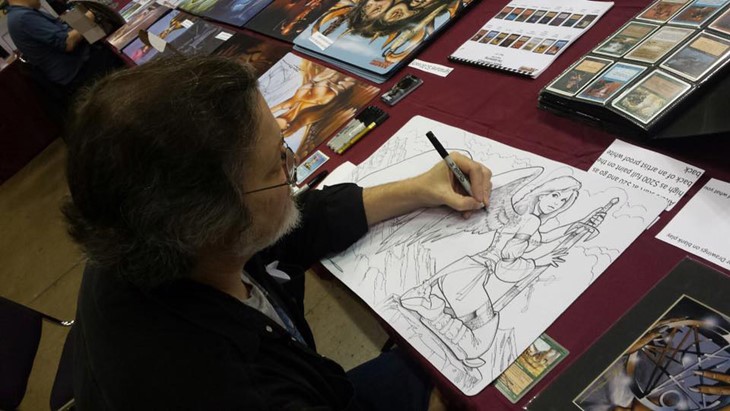
As an illustrator, what were the major changes in the industry since 93?
The biggest change in the industry has definitely been the switch to digital arts. When I started, we all did our work on traditional mediums with oil paints, airbrush, or watercolors. Now, everything is digital. The advantage of digital work is that it's faster to create, can be erased and created again, and can be emailed directly to the Art Director. The disadvantage is that there's no original painting, which I struggle with from time to time. Digital effects are great, but so is the opportunity to have an original from time to time. It's a tradeoff, for sure.
What has been your favorite plane/expansion to work on?
I can't say for certain that I have a definite favorite expansion that I've worked on, although I've enjoyed the silly expansions such as Unglued quite a bit.
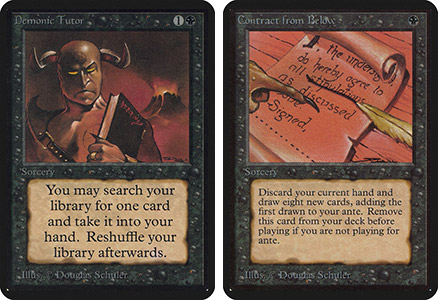
You painted some of the game's most iconic cards, do you get a lot of requests from the players about these cards?
Constantly. I get cards through the mail, from friends, at conventions, and even from relatives. I've been asked to airbrush Serra Angel on a motorcycle, airbrush Frozen Shade on t-shirts, design tattoos of Demonic Tutor, and do oil paintings of many of my more recognizable images.
What I think I find the most striking is how much some of the simpler images resonate to this day, with players commenting at almost every show "this art was my childhood". Funny thing is, I feel the same way about the things I grew up with, so I can identify with the feeling.
Oddly, I think the simpler images are the ones that gather the strongest responses. When we were first assigned images, we were working very small and were instructed that the final art would be an inch or two at most.
We were encouraged to keep the backgrounds plain, the colors bold, and the characters simple. I made a conscious choice to use high contrast in my art so that the characters would 'pop', which is where Serra Angel, Icy Manipulator, and many others came from - the need to craft art that would show at a very tiny size.
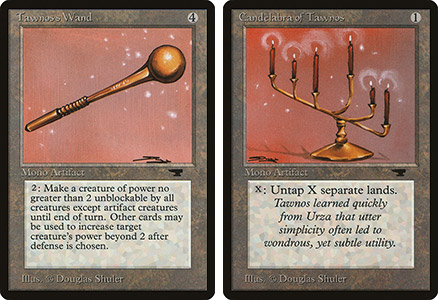
What were some of the most challenging cards to paint, and why?
As the sets went on, artists were increasingly instructed to work in details. More and more details. It took longer to make each piece and the restrictions were tighter. I know Wizards was trying to achieve a more consistent look with a more high-art look, but at the cost of certain freedoms from the artists.
In my particular case, I think my most difficult card might have been Crawlspace from Urza's Legacy, but not for anything Wizards was doing.
I was painting the card in a hotel on the way to a convention, watching the news and doing my thing. Suddenly, an alert came across the television that there was a tornado passing overhead! The windows were rocking, alarms were screaming, and I could see debris blowing down the street... but I kept painting because I had a deadline! What was I thinking? Because of the memories, that's one painting I refuse to sell.
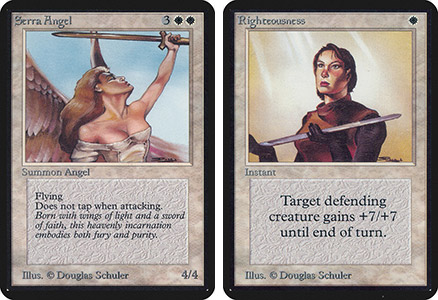
Greater Good is one of my favorite arts in the game. How do you recall painting it?
Greater Good was the last piece I did for Wizards, so my feelings on the work are bittersweet. The description was to paint a statue in the desert that had plants of some sort growing out of it.
I had a sense that things were ending for me, and so I designed an image that sort of captured my feelings at the time -- serene and quiet, and yet there was a new growth coming.
I moved on and have done some of my best work ever since.
Of the art you made for Magic, can you name some favorites?
That would be like choosing favorites between my children! I think I secretly like aspects of some pieces more than others, but I've noticed that my preferences change through the years and I appreciate different pieces at different times, for different reasons.
There's the technical achievements of Old Fogey, the serenity of the Islands from Mirage, the power from Demonic Tutor, and of course the fame of Serra Angel. I also know I get sick of certain cards when I see them all the time... ha!
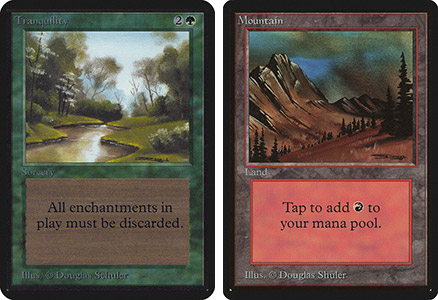
What do you consider to be the defining factors behind the game's longevity?
I don't think I can explain the game's longevity, but I've come to terms with the fact that it'll be part of my life until the end. After almost 30 years, it's still one of the most defining parts of my career.
Magic has opened incredible doors for me and has allowed me to live a good life. Even though I haven't done any new work for Wizards since 2004, I still sign fan mail, I still attend conventions, and I still get regular requests for work. As an artist, that's a good place to be.
I try to enjoy the ride the best I can and continue to appreciate the fans for everything they've done for me.

Is it true you made three versions of Serra Angel? There was an article that said one of the artworks had gone missing, can you comment on this?
I did make several versions of the Serra, but to preserve the privacy of collectors, I won't comment what's happened to them after they leave my possession.
I will point out that the article you linked is not correct -- it even got my name wrong by calling me 'Richard' ("...the story goes that Richard Shuler made three versions of this artwork...").
What can you tell us about you post-Magic work?
Since Magic, I've worked extensively in video games and have recently been exploring comics and book covers. Who knows... maybe one day I'll work for Magic again. I think that would be cool. :)
Where can our readers find more about your work?
So much of my work is private commissions that I don't put much online. My website is douglasshuler.com, and I also have a gallery at deviantart.com/douglasshuler. Both currently suffer from being out of date, but I'm working on that.
